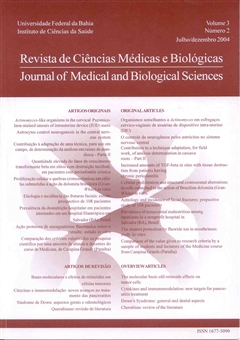Actinomyces-like organisms in the cervical Papanicolaou-stained smears of intrauterine device (IUD) users
DOI:
https://doi.org/10.9771/cmbio.v3i2.4420Keywords:
Actinomycosis, IUD, Cervix, Cervicovaginal smear.Abstract
The prevalence of Actinomyces-like organisms in cervicovaginal smears of 2,347 Brazilian women, including 151 (6.4%) intrauterine devices (IUD) users for at least six months and as controls 2,196 (93.6%) non-wearers of similar age using hormonal, barrier, or other contraceptive methods or none, living in Salvador, Bahia, has been investigated. Cervical smears were stained by the Papanicolaou method for the microscopic examination of Actinomyces-like organisms. The relationship between Actinomyces-like organisms infection and contraceptive methods, age and number of sexual partners has been analyzed. The result showed that the overall detection rate of Actinomyces-like organisms in 2,347 women was 0.17%. The detection rates in IUD users and non-users were 1.32% and 0.09% respectively. The prevalence rate (1.32/0.09) was of 14.7, indicating a risk fourteen times greater for the presence of Actinomyces-like organisms in cervical smears of IUD users. No contraceptive methods were used by 43% of the patients. Most patients were between 21 and 30 years old, having 3-5 sexual partners.Downloads
Download data is not yet available.
Downloads
How to Cite
Costa, Z. da, Ruas, N. M. C., Nascimento Sobrinho, C. L., Barbosa, G. G. de A., Sadigursky, M., & Barbosa Júnior, A. de A. (2004). Actinomyces-like organisms in the cervical Papanicolaou-stained smears of intrauterine device (IUD) users. Journal of Medical and Biological Sciences, 3(2), 159–164. https://doi.org/10.9771/cmbio.v3i2.4420
Issue
Section
ORIGINAL ARTICLES
License
The Journal of Medical and Biological Sciences reserves all copyrights of published works, including translations, allowing, however, their subsequent reproduction as transcription, with proper citation of source, through the Creative Commons license. The periodical has free and free access.


